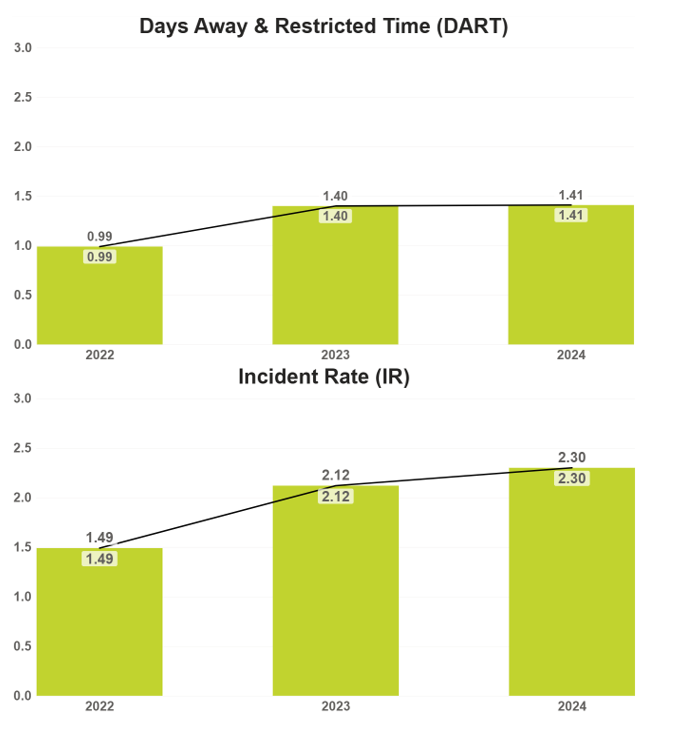Safety

As one of our values, safety is at the forefront of our decisions, actions, and behaviors. Our people-first approach supports our commitment to an injury-free workplace.
Our culture of safety is a shared responsibility. Everyone is accountable for performing their jobs in a safe manner. Everyone must comply with all applicable safety laws and regulations. Everyone must understand and follow the safety policies and procedures related to their job. Everyone is empowered to intervene or stop work if they believe circumstances may be unsafe – because nothing we do is worth someone getting hurt.
Our company strategy outlines our shared expectations and accountability. Our managers and supervisors commit to:
- Modeling safety as a core value in all business operations and decisions.
- Making safety and health ownership a shared role with associates.
- Managing risk by analyzing leading indicators and safety incidents to ensure that corrective actions address all contributing factors.
- Measuring associate engagement in the safety process by tracking leading and lagging key performance indicators.
- Coordinating between business divisions to share, evaluate, and implement best safety practices from within and outside the company.
- Complying with all regulatory requirements and applying best safety practices that meet or exceed those requirements.
Our associates commit to:
- Being accountable for their personal safety and the safety of their fellow coworkers.
- Intervening in any observed unsafe action or condition encountered in the workplace.
- Stopping work if there is an unacceptable risk to worker or operation safety.
- Participating in all safety and health activities including training, use of risk reduction tools, and respectful communication with coworkers and management.
Boise Cascade employs an all-inclusive approach to workplace safety. From new hires to executive leaders, all of our associates are given the tools and training to help understand how to do their jobs safely and to foster personal accountability, including holding others to same standard of safety.
Training, advanced data collection, and analysis as well as a robust communication strategy give our associates and management the best opportunity to make Boise Cascade a place where nobody gets hurt.
Here are some examples of our practices:
- Our locations have peer-led safety committees that create, promote, and improve initiatives at their facility.
- We regularly recognize and celebrate safety milestones and acknowledge teams that have achieved zero-incident milestones or have made outstanding contributions to improve safety practices at their facility.
- Contractors, vendors, and visitors receive a safety orientation before entering our facilities.
- Our facilities are places where it is safe to speak up if an associate has concerns or needs to stop the work in order to ensure any risks are immediately addressed.
- We continuously learn from our audits, industry best practices, and innovations in technology that help us provide a safe workplace.
The pursuit of excellence is one of our values. We know establishing a strong safety culture is not enough unless we maintain and enhance it. A low number of incidents does not guarantee future success. Continuous face-to-face discussions between our associates and the management staff are the backbone of a strong safety culture.
To continue a focus on leveraging best practices and learnings across the company that will enhance safety performance, we are working towards a single-source repository: a document management system that allows users to easily access safety-related material including policies, procedures, job hazard analysis, and training presentations through our intranet portal.
When it comes to metrics, Boise Cascade focuses on the precursor events to an incident, often called “leading indicators.” We share results through reports generated by our safety data processing system Origami as well as breakroom signage and posts on our intranet site. Communication helps our associates connect how the effort of collecting and evaluating metrics leads to tangible, meaningful improvements in safety.
We monitor safety activities to know what our associates are doing on a regular basis to prevent injuries. “Leading indicators” include hazard identifications, peer-to-peer observations and interventions, pre-task analyses, near-miss reports, and reports of soreness. We track other “lagging indicators” which includes injury severity, property damage incidents, and workers compensation costs. Our data-driven focus drives better decision-making at all levels and improves performance. Two of the many performance metrics we track include our Incident Rate (IR), an industry measure of OSHA recordable injuries, and Days Away & Restricted Time (DART).

We will always comply with Federal and State regulations for worker safety. Wherever possible, we exceed those standards by participating in optional certification programs, such as the Occupational Safety and Health Administration (OSHA) Voluntary Protection Programs (VPP). Our engineered wood products plant in Alexandria, LA, and our plywood plant in Oakdale, LA, have been recognized for VPP achievements.
Boise Cascade is an industry leader in safety. Our safety professionals sit on the committees of many different safety, industry, and national standard-setting organizations. Our facilities are also recognized in industry-wide programs such as the APA Safety & Health Awards and the Western Wood Products Association Safety Awards.
In 2020, we established our own in-house CEO Safety Excellence Recognition program to honor our manufacturing plants and distribution branches on an annual basis for demonstrating outstanding safety leadership, collaboration, and innovation that positively impacts safety in their operations.
Celebrating success is one way we positively reinforce and encourage continual safe behaviors in our workplace.